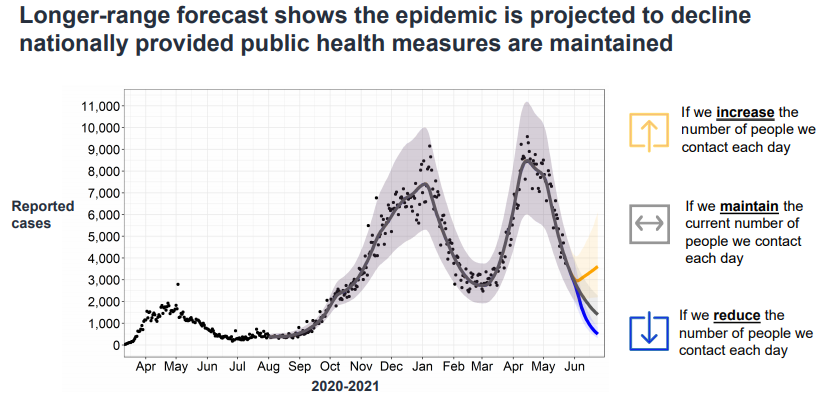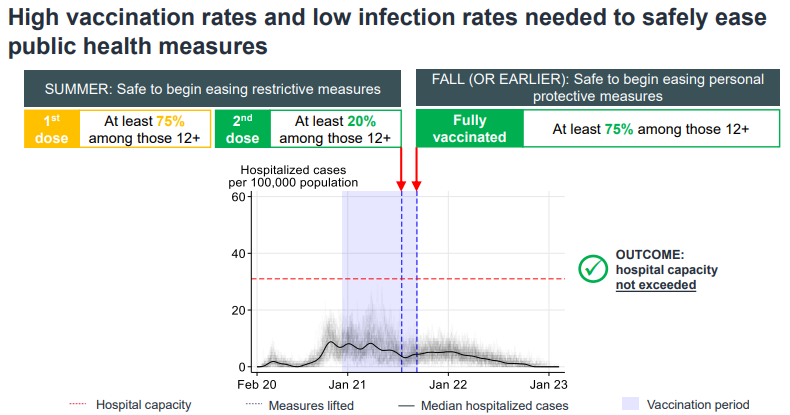Tam warns against easing measures as COVID-19 cases decline nationally

As the third wave of COVID-19 fizzles out across Canada, federal health officials have said that relaxing public health measures now would cause a resurgence of the pandemic.
Dr. Theresa Tam, Canada’s chief public health officer, released updated COVID-19 modelling data on Friday that shows how the country is faring against the virus.
Across Canada, there has been a decline in both virus cases and severity indicators, including hospitalizations and ICU admissions, although both “remain high” in some areas.
The long-range forecast, which predicts how the pandemic may evolve through to the middle of June, shows that the third wave will continue to decline across the country if public health measures are maintained.
“While this forecast is very encouraging, it reaffirms that now is not the time to relax our measures,” Tam said.
“If measures are relaxed, and the number of community-wide in-person contacts increases, resurgence is likely.”
The data shows that if Canadians increase the number of people they have contact with each day, the country could see upwards of 3,500 new cases per day in June.
If people reduce their close contacts, the data predicts fewer than 1,000 daily cases next month. If measures stay the same, Canada should see roughly 1,500 cases per day.

Public Health Agency of Canada
High vaccination rates and low infection rates are needed in order for public health measures to be safely lifted, Tam said.
Once 75% of the population aged 12 and older has had one vaccine dose, and at least 20% has had two doses, the “most restrictive” measures, such as lockdowns, can be eased.
Officials are aiming to meet the vaccination benchmark this summer.
“Though we will still need to maintain individual precautions, such as masking and spacing around non-household members, we will be able to gather in smaller groups outdoors, dine on restaurant patios, and safely enjoy outdoor activities,” Tam said.
Once 75% of the population aged 12 and over is fully vaccinated — a line hopefully crossed by the fall — it “may be safe” to start easing personal protective measures.
The modelling shows, Tam said, that taking a phased approach will make it safer to lift both public health restrictions and individual precautions.

Public Health Agency of Canada
As of May 22, more than 60% of Canadians aged 18 and over have received their first vaccine dose.
Those aged 18 to 29 have the lowest immunization rate, with less than 35% having been partially vaccinated, and under 5% being fully vaccinated.
The more younger people — many of whom have higher contact rates — that get vaccinated, the better Canada’s control of COVID-19 will be, Tam noted.
“Success is within our reach,” she said. “We still have a ways to go before we can safely ease measures without risking a resurgence that could overwhelm healthcare capacity.”
- See also:
When asked whether Canada would do away with hotel quarantine for international travellers, which has been recommended by a COVID-19 expert advisory panel, Tam said officials would be “laying a path forward” in the near future and would consider the report.
Although she stopped short of saying whether the measure would be extended or abolished, Tam noted that the negative test required to enter Canada from abroad, combined with the country’s own growing vaccination rates, affords a “great deal of risk reduction.”
“We will be certainly looking at different indicators. Some of that includes how Canada itself is doing,” Tam said.
“When a country is still in the middle of a third wave, and we haven’t as yet attained a good level of immunity from a population perspective, then it’s more difficult for us to tolerate importations.”
To date, Canada has seen 1,371,073 COVID-19 cases and 25,411 virus-related deaths.

